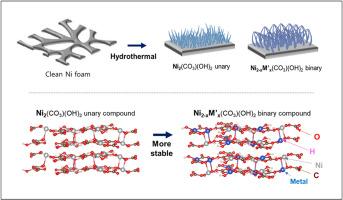设计用于光存储系统的高性能二元碳酸盐/氢氧化物镍基超级电容器
IF 9
1区 工程技术
Q1 ENERGY & FUELS
引用次数: 0
摘要
硅太阳能电池用于将太阳能转化为电能,而超级电容器则用于储存这些能量。为了最大限度地扩大电极的表面积,我们采用了三维泡沫镍基板,并在其上沉积了镍基化合物,以提高电极的电化学性能。具体来说,为了解决仅使用镍离子会导致电导率降低的问题,我们引入了过渡金属离子,如锰、钴、铜、铁和锌,以创建二元化合物作为电极材料。这些二元金属化合物具有高电子传导性、结构稳定性和可逆容量,从而优化了超级电容器的性能。因此,优化后的镍钴(CO3)(OH)2 电极表现出了高容量和出色的循环稳定性,作为非对称超级电容器装置,能量密度达到 35.5 Wh kg-1,功率密度达到 2555.6 W kg-1。此外,当该装置与硅太阳能电池直接结合时,在照明强度为 10 mW cm-2 的条件下,其存储效率达到 63%,总效率达到 5.17%。这些研究结果表明,高性能自充电储能装置具有商业化的潜力,并将极大地推动储能技术的发展。本文章由计算机程序翻译,如有差异,请以英文原文为准。

Design of high-performance binary carbonate/hydroxide Ni-based supercapacitors for photo-storage systems
Silicon solar cells were used to convert solar energy into electrical energy, and a supercapacitor was designed to store this energy. To maximize the surface area of the electrodes, a three-dimensional Ni foam substrate was employed, onto which Ni-based compounds were deposited to enhance the electrochemical performance of the electrodes. Specifically, to address the conductivity reduction problem that arises when using only Ni ions, we introduced transition metal ions such as Mn, Co, Cu, Fe, and Zn to create binary compounds as electrode material. These binary metal compounds provided high electronic conductivity, structural stability, and reversible capacity, thereby optimizing the performance of the supercapacitor. As a result, the optimized NiCo(CO3)(OH)2 electrode demonstrated high capacity and excellent cycle stability, exhibiting an energy density of 35.5 Wh kg−1 and a power density of 2555.6 W kg−1 as an asymmetric supercapacitor device. Furthermore, when this device was combined directly with silicon solar cells, it achieved a storage efficiency of 63 % and an overall efficiency of 5.17 % under an illumination intensity of 10 mW cm−2. These findings suggest the potential for commercializing high-performance self-charging energy storage devices and contribute significantly to the advancement of energy storage technology.
求助全文
通过发布文献求助,成功后即可免费获取论文全文。
去求助
来源期刊

Energy
工程技术-能源与燃料
CiteScore
15.30
自引率
14.40%
发文量
0
审稿时长
14.2 weeks
期刊介绍:
Energy is a multidisciplinary, international journal that publishes research and analysis in the field of energy engineering. Our aim is to become a leading peer-reviewed platform and a trusted source of information for energy-related topics.
The journal covers a range of areas including mechanical engineering, thermal sciences, and energy analysis. We are particularly interested in research on energy modelling, prediction, integrated energy systems, planning, and management.
Additionally, we welcome papers on energy conservation, efficiency, biomass and bioenergy, renewable energy, electricity supply and demand, energy storage, buildings, and economic and policy issues. These topics should align with our broader multidisciplinary focus.
 求助内容:
求助内容: 应助结果提醒方式:
应助结果提醒方式:


